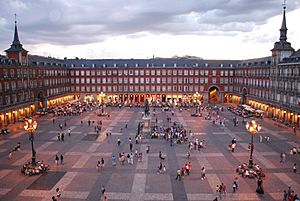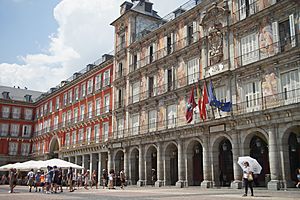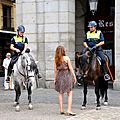Plaza Mayor, Madrid facts for kids
Quick facts for kids Plaza Mayor of Madrid |
|
|---|---|
 |
|
| Location | Madrid, Spain |
| Official name: Plaza Mayor de Madrid | |
| Type | Non-movable |
| Criteria | Monument |
| Designated | 1985 |
| Reference no. | RI-51-0005006 |
| Lua error in Module:Location_map at line 420: attempt to index field 'wikibase' (a nil value). | |
The Plaza Mayor (which means Main Square in English) is a very important public space. You can find it right in the middle of Madrid, the capital city of Spain. This square used to be the busy center of Old Madrid.
It was first built between 1580 and 1619. This happened during the time when King Philip III ruled Spain. Just a short walk away from the Plaza Mayor is another famous spot called the Puerta del Sol. Today, the Plaza Mayor is a popular place. People from Madrid and tourists come here to shop, walk around, eat, and enjoy being outdoors.
Contents
History and Design of Plaza Mayor
The Plaza Mayor has a long history, going back to the 15th century. Back then, it was called "Plaza del Arrabal." It was the main market area for the town. In 1561, the plaza became part of the city of Madrid.
King Philip II asked a famous architect named Juan de Herrera to redesign the area. But the actual building work didn't start until 1617. This was during the rule of King Philip III. Another architect, Juan Gómez de Mora, continued the work. The first version of the square was finished two years later, in 1619.
Fires and Rebuilding the Square
The Plaza Mayor has been damaged by three big fires. The first fire happened in 1631. After this, Juan Gómez de Mora was in charge of rebuilding the square. The second fire took place in 1670. Architect Tomás Román led the reconstruction that time.
The last and biggest fire happened in 1790. It destroyed about one-third of the square. Today, the design of the Plaza Mayor is mostly thanks to Juan de Villanueva. He managed the rebuilding after the huge 1790 fire. Before this fire, the buildings around the square were five stories tall. Juan de Villanueva changed them to three stories. He also closed off the corners and made large entrances into the square. After Juan de Villanueva passed away, Antonio López Aguado and Custodio Moreno finished the construction in 1854.
What the Plaza Looks Like Today
Today, the Plaza Mayor has a rectangular shape. All the buildings around it look very similar, which gives it a uniform look. The square is about 129 meters (423 feet) long and 94 meters (308 feet) wide. The three-story buildings facing the square have 237 balconies.
You can enter or leave the Plaza Mayor through ten different entrances, which are like nine gates. Their names are: 7 de Julio, Arco de Triunfo, and Felipe III to the North. Sal, Zaragoza, and Gerona are to the East. Botoneras, Toledo, and Cuchilleros are to the South. Ciudad Rodrigo is to the West.
In the middle of the square, there is a statue of King Philip III on a horse. This statue was placed there in 1848.
Events and Uses of the Plaza
The Plaza Mayor has been the site of many important events throughout history. In the past, it was a place for public events like bullfights and even soccer games. Today, it hosts the yearly Christmas market. On Sundays and holidays, you can find a market for stamp and coin collectors there in the mornings.
In 1880, a special building called the Casa de la Panadería was repaired. This building is the one with two towers on its sides. It has been used for many different things over time. Its name means "House of the Bakery" because it was once the main bakery for the city.
In the 1960s, cars were no longer allowed in the plaza. An underground parking lot was built below it. In 1992, the Casa de la Panadería got new wall paintings by Carlos Franco. These paintings show figures from old myths.
Today, the Plaza Mayor is a major spot for tourists. But it's also loved by the people of Madrid and is an important part of Spanish culture. Near the Plaza Mayor, on Arco de Cuchilleros Street, you'll find Restaurante Botin. It is known as the oldest restaurant in the world!
How the Plaza Got Its Name

The name of the Plaza has changed many times over the years. It has been called "Plaza del Arrabal," "Plaza de la Constitución," "Plaza Real," and "Plaza de la República." Now, it is known as "Plaza Mayor." These different names show important events and changes in Spanish history.
"Plaza del Arrabal" was the first name of what is now the Plaza Mayor. It was the most popular marketplace until the late 1400s. After Spain's Constitution of 1812 was created, all major squares in Spain were renamed "Plaza de la Constitución." The square also held this name at other times, like from 1820 to 1823.
When the Borbón king returned to power in 1814, it became known as the "Plaza Real." In 1873, the name changed to "Plaza de la República." After the Spanish Civil War ended, the plaza received its current name, "Plaza Mayor."
The Statue of King Philip III
In the middle of the square, there is a bronze statue of King Philip III. It was made in 1616 by artists Jean Boulogne and Pietro Tacca. Even though it was made in 1616, the statue wasn't placed in the center of the square until 1848.
The statue was a gift from the Duke of Florence. Queen Isabel II ordered it to be moved from a place called Casa de Campo. She wanted it to be the main feature of the Plaza Mayor.
Photos
-
Philip III statue from 1616
Images for kids
-
Auto-de-fé in the Plaza Mayor of Madrid, a 1683 oil painting by Francisco Rizi (Museo del Prado).
See also
 In Spanish: Plaza Mayor de Madrid para niños
In Spanish: Plaza Mayor de Madrid para niños













